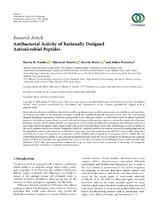Antibacterial activity of rationally designed antimicrobial peptides.

View/
Date
2020Author
Morris, Thureyah
Tincho, Marius Belmondo
Meyer, Mervin
Metadata
Show full item recordAbstract
Many infectious diseases are still prevalent in the world’s populations since no effective treatments are available to eradicate them.
e reasons may either be the antibiotic resistance towards the available therapeutic molecules or the slow rate of producing
adequate therapeutic regimens to tackle the rapid growth of new infectious diseases, as well as the toxicity of current treatment
regimens. Due to these reasons, there is a need to seek and develop novel therapeutic regimens to reduce the rapid scale of bacterial
infections. Antimicrobial Peptides (AMPs) are components of the first line of defense for prokaryotes and eukaryotes and have a
wide range of activities against Gram-negative and Gram-positive bacteria, fungi, cancer cells, and protozoa, as well as viruses. In
this study, peptides which were initially identified for their HIV inhibitory activity were further screened for antibacterial activity
through determination of their kinetics as well as their cytotoxicity. From the results obtained, the MICs of two AMPs (Molecule 3
and Molecule 7) were 12.5 μg/ml for K. pneumoniae (ATCC 700603) and 6.25 μg/ml for P. aeruginosa (ATCC 22108). e two
AMPs killed these bacteria rapidly in vitro, preventing bacterial growth within few hours of treatment. Furthermore, the cytotoxic
activity of these two peptides was significantly low, even at an AMP concentration of 100 μg/ml. ese results revealed that
Molecule 3 and 7 have great potential as antibacterial drugs or could serve as lead compounds in the design of therapeutic
regimens for the treatment of antibiotic-resistant bacteria.
